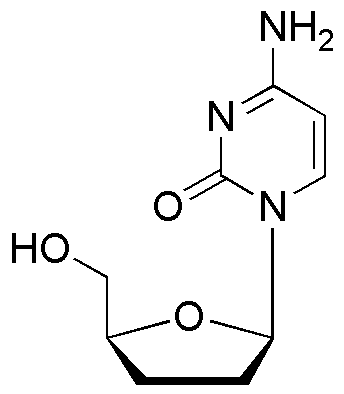2',3'-Dideoxycytidine is widely utilized in research focused on:
- Antiviral Therapy: This compound is primarily used in the treatment of HIV, where it acts as a nucleoside reverse transcriptase inhibitor, helping to reduce viral load and improve patient outcomes.
- Research in Cancer Treatment: It has shown potential in cancer research, particularly in studies targeting specific types of leukemia and lymphoma, by disrupting DNA synthesis in rapidly dividing cells.
- Development of Antiviral Drugs: The compound serves as a crucial building block in the synthesis of new antiviral agents, aiding researchers in developing more effective treatments against various viral infections.
- Studying Nucleic Acid Metabolism: It is used in laboratory settings to investigate the metabolism of nucleic acids, providing insights into cellular processes and the mechanisms of drug action.
- Formulating Combination Therapies: Researchers explore its use in combination with other antiretroviral drugs to enhance efficacy and reduce the likelihood of resistance in viral infections.
Información general
Propiedades
Seguridad y normativas
Aplicaciones
2',3'-Dideoxycytidine is widely utilized in research focused on:
- Antiviral Therapy: This compound is primarily used in the treatment of HIV, where it acts as a nucleoside reverse transcriptase inhibitor, helping to reduce viral load and improve patient outcomes.
- Research in Cancer Treatment: It has shown potential in cancer research, particularly in studies targeting specific types of leukemia and lymphoma, by disrupting DNA synthesis in rapidly dividing cells.
- Development of Antiviral Drugs: The compound serves as a crucial building block in the synthesis of new antiviral agents, aiding researchers in developing more effective treatments against various viral infections.
- Studying Nucleic Acid Metabolism: It is used in laboratory settings to investigate the metabolism of nucleic acids, providing insights into cellular processes and the mechanisms of drug action.
- Formulating Combination Therapies: Researchers explore its use in combination with other antiretroviral drugs to enhance efficacy and reduce the likelihood of resistance in viral infections.
Documentos
Hojas de datos de seguridad (HDS)
La SDS proporciona información de seguridad completa sobre la manipulación, el almacenamiento y la eliminación del producto.
Especificación del producto (PS)
La PS proporciona un desglose completo de las propiedades del producto, incluida la composición química, el estado físico, la pureza y los requisitos de almacenamiento. También detalla los rangos de calidad aceptables y las aplicaciones previstas del producto.
Certificados de análisis (COA)
Busque certificados de análisis (COA) ingresando el número de lote del producto. Los números de lote y de partida se pueden encontrar en la etiqueta de un producto después de las palabras "Lote" o "Lote".
Número de catálogo
Número de lote/lote
Certificados de origen (COO)
Este certificado de origen confirma el país en el que se fabricó el producto y también detalla los materiales y componentes utilizados en él y si se deriva de fuentes naturales, sintéticas u otras fuentes específicas. Este certificado puede ser necesario para cumplir con las normativas aduaneras, comerciales y regulatorias.
Número de catálogo
Número de lote/lote
Hojas de datos de seguridad (HDS)
La SDS proporciona información de seguridad completa sobre la manipulación, el almacenamiento y la eliminación del producto.
DownloadEspecificación del producto (PS)
La PS proporciona un desglose completo de las propiedades del producto, incluida la composición química, el estado físico, la pureza y los requisitos de almacenamiento. También detalla los rangos de calidad aceptables y las aplicaciones previstas del producto.
DownloadCertificados de análisis (COA)
Busque certificados de análisis (COA) ingresando el número de lote del producto. Los números de lote y de partida se pueden encontrar en la etiqueta de un producto después de las palabras "Lote" o "Lote".
Número de catálogo
Número de lote/lote
Certificados de origen (COO)
Este certificado de origen confirma el país en el que se fabricó el producto y también detalla los materiales y componentes utilizados en él y si se deriva de fuentes naturales, sintéticas u otras fuentes específicas. Este certificado puede ser necesario para cumplir con las normativas aduaneras, comerciales y regulatorias.


